Odisha State Board CHSE Odisha Class 12 Biology Important Questions Chapter 2 Sexual Reproduction in Flowering Plants Important Questions and Answers.
CHSE Odisha 12th Class Biology Important Questions Chapter 2 Sexual Reproduction in Flowering Plants
Sexual Reproduction in Flowering Plants Class 12 Important Questions CHSE Odisha
Very Short Answer Type Questions
Choose the correct option
Question 1.
The cushion of parenchymatous cells that joins ovary and ovule is known as
(a) nucellus
(b) placenta
(c) hilum
(d) funiculus
Answer:
(b) placenta
Question 2.
The narrow pore at one end of the ovule is called as
(a) funiculus
(b) chalaza
(c) micropyle
(d) hilum
Answer:
(c) micropyle
Question 3.
Megagametogenesis is the process of formation of embryo sac from
(a) pollen grain
(b) microspore
(c) ovule
(d) megaspore
Answer:
(d) megaspore
Question 4.
Antipodal cells are three in number and occur towards
(a) chalazal pole
(b) micropylar pole
(c) Both (a) and (b)
(d) None of the above
Answer:
(a) chalazal pole
Question 5.
Filiform apparatus is a characteristic feature of
(a) egg
(b) synergid
(c) zygote
(d) suspensor
Answer:
(b) synergid
![]()
Question 6.
Of the three cells in the micropylar end of the embryo sac, the central one is the egg cell and the other two are called ……..
(a) synergids
(b) antipodals
(c) generative cells
(d) vegetative cells
Answer:
(a) synergids
Question 7.
Wind pollination is common in
(a) lilies
(b) grasses
(c) orchids
(d) legumes
Ans.
(b) grasses
Question 8.
Nocturnal flowers like Nyctanthes attract insects by their …….. .
(a) colour
(b) nectar
(c) scent
(d) edible sap
Answer:
(c) scent
Question 9.
Adaptation of some floral parts, which acts as barriers to self-pollination is called …….. .
(a) dichogamy
(b) herkogamy
(c) homogamy
(d) cleistogamy
Answer:
(c) homogamy
Question 10.
In …….. pollen tube enters through micropyle into the ovule.
Or Entry of pollen tube through micropyle during fertilisation is called …….. .
(a) porogamy
(b) chalazogamy
(c) mesogamy
(d) herkogamy
Answer:
(a) porogamy
Question 11.
Fusion of the male gamete with …….. in the embryo sac of angiosperms forms the primary endosperm nucleus.
(a) antipodals
(b) synergids
(c) polar nuclei
(d) egg cells
Answer:
(c) polar nuclei
Question 12.
Individual part or segment of calyx is called
(a) sepal
(b) petal
(c) tepal
(d) corolla
Answer:
(a) sepal
Question 13.
Chalazal pole is present
(a) opposite to micropyle
(b) at the origin of integuments
(c) opposite to nucellus
(d) near the embryo sac
Answer:
(a) opposite to micropyle
Question 14.
In angiosperms, triple fusion is required for the formation of
(a) embryo
(b) endosperm
(c) seed coat
(d) fruit wall
Answer:
(b) endosperm
Question 15.
Zygote divides by an asymmetric mitotic division to form two cells. Out of these, the cells towards chalazal side is known as
(a) apical cell
(b) basal cell
(c) Both (a) and (b)
(d) None of these
Answer:
(a) apical cell
![]()
Question 16.
Basal cell divides to produce
(a) haustorium
(b) suspensor
(c) hypobasal cell
(d) epibasal cell
Answwer:
(b) suspensor
Question 17.
The part of embryonal axis above the level of cotyledons is called
(a) epicotyl
(b) hypocotyl
(c) Both (a) and (b)
(d) None of these
Answer:
(a) epicotyl
Question 18.
Root cap enclosed in an undifferentiated sheath is called
(a) epicotyl
(b) coleorhiza
(c) coleoptile
(d) scutellum
Answer:
(b) coleorhiza
Question 19.
Which type of endosperm is found in Asphodelusl
(a) Helobial
(b) Cellular
(c) Nuclear
(d) Both (a) and (b)
Answer:
(a) Helobial
Question 20.
True polyembryony occurs in
(a) Citrus
(b) Mangifera
(c) Opuntia
(d) All of these
Answer:
(d) All of these
Question 21.
Adventive embryony in Citrus is due to
(a) nucellus
(b) integuments
(c) zygotic embryo
(d) fertilised egg
Answer:
(a) nucellus
Question 22.
Formation of gametophyte directly from sporophyte without meiosis is
(a) apospory
(b) apogamy
(c) parthenogenesis
(d) amphimixis
Answer:
(a) apospory
![]()
Question 23.
Albuminous seed
(a) has no endosperm
(b) has thick cotyledons
(c) have food storage in cotyledons
(d) Both (a) and (c)
Answer:
(c) have food storage in cotyledons
Correct the sentences, if required, by changing the underlined word
Question 1.
Plants with male and female reproductive structures present on the same plant is called dioecious.
Answer:
monoecious
Question 2.
Stamen helps in production of megaspores, fruits and seeds.
Answer:
Gynoecium
Question 3.
Potential pollen mother cell gives rise to megaspores.
Answer:
microspore tetrad
Question 4.
The inner sterile tissue that provides nourishment to the developing microspores in microsporogenesis is called endothecium.
Answer:
tapetum
Question 5.
The mode of arrangement of ovule along the placenta in the cavity of the ovary is known as style.
Answer:
placentation
Question 6.
In protandrous flower, carpels mature earlier than stamens.
Answer:
protogynous
Question 7.
An ovule is a differentiated megasporangium.
Answer:
integumented
Question 8.
Megaspore mother cell is found near the region of nucellus.
Answer:
nucellus
Question 9.
The tegmen marks the point of attachment to the stalk.
Answer:
The hilum marks the point of atta’chment to the stalk.
Question 10.
Perisperm is remnents of embryo.
Answer:
Perisperm is remnents of nucellus.
![]()
Question 12.
Apomixis is the development of seeds with fertilisation.
Answer:
Apomixis is the development of seeds without fertilisation.
Question 13.
Thalamus contributes in the fruit formation in apple.
Answer:
True
Fill in the blanks
Question 1.
The stalk of ovule by which it is connected to placenta is called …………. .
Answer:
funiculus
Question 2.
A mass of parenchyma cells, surrounded by integuments and encloses embryo sac is called ………. .
Answer:
nucellus
Question 3.
………. is formed of a chemical called sporopollenin.
Answer:
Exine
Question 4.
A flower is said to ………. when either of the two
sexes is missing.
Ans. imperfect
Question 5.
Aquatic plants like water hyacinth and water lily are pollinated by ……….. .
Answer:
entomophily (insects)
Question 6.
Intine is made up of ………….. .
Answer:
cellulose and pectin
Question 7.
In a zygote, the terminal cell situated towards chalazal pole is called ………….. .
Answer:
apical cell or embryonal cell.
Question 8.
The position of plumule in monocot embryo is ………… .
Answer:
lateral
Question 9.
The part of pistil which develops into fruits is …………. .
Answer:
ovary
![]()
Question 10.
The thick swollen embryonal leaf filled with reserve food is called …………… .
Answer:
cotyledon
Express in one or two word(s)
Question 1.
Name the pollination preferred by snails.
Answer:
Malacophily
Question 2.
The flowers which are bisexual and never open.
Answer:
Cleistogamous flowers.
Question 3.
Stigma of a flower matures earlier than the anther.
Answer:
Protogyny.
Question 4.
The individual members of a corolla.
Answer:
Petals.
Question 5.
Give the name of the type of ovule in which the hilum, chalaza and the micropyle lie in the same longitudinal axis.
Answer:
Orthotropous
Question 6.
Name the type of pollination as a result of which genetically different types of pollen grains of same species land on the stigma.
Answer:
Xenogamy
Question 7.
A type of endosperm, which is an intermediate between cellular and nuclear type.
Answer:
Helobial endosperm.
![]()
Question 8.
The portion of the embryonal axis above the level of attachment of scutellum.
Answer:
Epicotyl
Question 9.
An embryo sac directly produced from a nucellar cell.
Answer:
Aposporous embryo sac.
Question 10.
Embryonal axis above the level of cotyledons.
Answer:
Plumule
Question 11.
Embryonal axis below the level of cotyledons.
Answer:
Radicle
Short Answer Type Questions
Question 1.
What is microsporogenesis? Where does it occur in angiosperms? What is its significance?
Answer:
Microsporogenesis:
Each cell of the sporogenous tissue is a potential Pollen Mother Cell (PMC) or microspore mother cell and can give rise to microspore tetrad. This process of formation of microspore from a pollen mother cell through the process of meiosis is called microsporogenesis.
As the anthers mature and dehydrate, the microspores dissociate from one another and form tetrad and develop into pollen grains. Inside each microsporangium, several thousands of microspores or pollen grains are formed that are released with the dehiscence of anther. In general, dehiscence of anther occurs through the rupture of anther lobe walls which causes release of several thousands of pollen grains at a time.
Question 2.
What is triple fusion? Where and how does it take place? Give the name of nuclei involved in triple fusion.
Answer:
The diploid zygote finally develops into’the embryo. The second male gamete fuses with the two polar nuclei or secondary nucleus in the central cell to form the triploid Primary Endosperm Nucleus (PEN). The process is called triple fusion as three haploid nuclei are involved in the fusion.
After triple fusion, the central cell becomes the Primary Endosperm Cell (PEC) which gives rise to the endosperm, while the zygote develops into the embryo. As both the fusions, syngamy and triple * fusion, occur in an embryo sac, the phenomenon is termed as double fertilisation.
Question 3.
Name all the haploid cells present in an unfertilised mature embryo sac of a flowering plant. Write the total number of cells in it.
Answer:
An unfertilised embryo sac of angiosperm is composed of 8-nuclei and 7 cells. Among 8 nuclei, 6 are enclosed by cell walls and organised into cell, while the remaining 2 nuclei (called polar nuclei) are situated above the egg apparatus.
Out of 6 cells, 3 ate grouped at micropylar end and constitute the egg apparatus, made up of 2 synergids and 1 egg cell. The other 3 are located at chalazal end and are called antipodals.
Question 4.
Explain the role of tapetum in the formation of pollen grain wall.
Answer:
Tapetum is the innermost layer of the microsporangium. It produces the exine layer of the pollen grains, which is composed of the sporopollenin, the most resistant fatty substance.
During microsporogenesis, the cells of tapetum produce various enzymes, hormones, amino acids and other nutritious materials required for the development of pollen grains.
![]()
Question 5.
How does the pollen grow through the style? Explain briefly.
Answer:
Growth of a Pollen Tube:
The pollen grains reach the receptive stigma of the carpel by the act of pollination. Pollen grains after getting attached to the stigma absorb water and swell. After compatible pollination, the pollen grain germinates on the stigma to produce a pollen tube through one of the germ pores. The contents of the pollen grain then move into this tube.
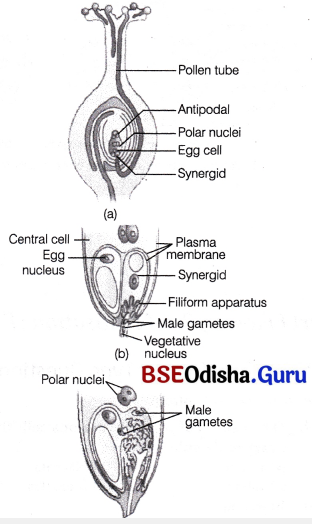
The pollen tube grows through the tissues of stigma and style by secreting the enzymes that digest them. In some plants that shed pollen at two-celled condition, the generative cell divides and forms the two male gametes during the growth of pollen tube in the stigma.
In plants which shed pollen in the three-celled condition, pollen carries the two male gametes from the beginning.
Question 6.
Make a list of any three outbreeding devices that flowering plants have developed and explain how they help to encourage cross-pollination.
Answer:
Adaptations (Contrivances) for Cross-Pollination or Outbreeding Devices
Continued self-pollination leads to chances of inbreeding depression. Thus, flowering plants have developed many devices to discourage self-pollination and to encourage cross-pollination. These include
1. Dichogamy In some plant species, receptivity of stigma and pollen release is not synchronised, i.e. often the pollen is released before the stigma becomes receptive (protandry) or stigma becomes receptive before the release of pollen (protogyny). This condition is called dichogamy.
2. Heterostyly In some other species, the anther and stigma are placed at different positions, so that the pollen cannot come in contact with the stigma of same flower. This condition is called heterostyly.
Both the above mentioned methods will prevent autogamy.
3. Self-incompatibility or Self-sterility is the third device to prevent inbreeding. It is a genetic phenomenon of preventing the pollen from fertilising ovules by the same flower by inhibiting pollen germination or pollen tube growth in the pistil. Self-incompatibility may be due to genotype of sporophyte known as sporophytic incompatibility, whereas if it is due to genotype of pollen, it is known as gametophytic incompatibility.
4. Dicliny or Unisexuality effectively prevents self-pollination. It is the presence of unisexual flowers in plants that prevents autogamy but not geitonogamy, e.g. castor, maize, etc.
5. Herkogamy is seen in orchids where male or female sex organs themselves prove as a barrier to prevent self-pollination by some structural abnormalities.
6. Dioecy Both autogamy and geitonogamy is prevented in several species like papaya, where male and female flowers are present on different plants, i.e. each plant is either male or female (dioecy).
Question 7.
What is significance of pollination?
Answer:
- Pollination is essential for fertilisation and production of seeds and fruits, which is necessary for continuity of plant life.
- Cross-pollination results in the production of plants with variations having new combination of characters of two different plants of the same species.
Question 8.
What is hydrophily? Name any hydrophilous plant and give its three important characters which help in pollination.
Answer:
It is the transfer of pollen grains from anthers to the stigma through the agency of water.
Vallisneria is a hydrophilous plant. It is a dioecious plant in which male flowers and female flowers are borne on separate plants. The important characteristics are pollination are .
- Flowers are small, colourless, nectarlless.
- Calyx and corolla and other floral parts are the unwettable. Mature male flowers abscise and float on water.
- Stigmas are well-exposed, long and sticky.
- Pollen grains and stigmas are unwettable.
After pollination female flowers are pulled inside the water.
Question 9.
Geitonogamous flowering plants are genetically autogamous but functionally cross-pollinated. Justify.
Answer:
Geitonogamous flowering plants have open bisexual flowers in which pollen grains from the anther are transferred to the stigma of another flower of same plant (genetically similar to autogamy) involving different
- pollination agent like the cross-pollination (functionally similar to cross-pollination).
Question 10.
Explain the function of each of the following
(i) Coleorhiza
(ii) Germ pores
Answer:
(i) Coleorhiza is a cap-like structure present over the radicle in case of monocot seed, e.g. maize grain. During germination, it grows to form a small tubular structure, which protects the enclosed growing radicle, in early stages of development.
(ii) Germ pores are the areas on the wall of pollen grains where the exine is thin or absent. The areas may have thickened intine or deposition of callose. The pollen tube comes out through one of the germ pores.
![]()
Question 11.
Where is sporopollenin present in plants? State its significance with reference to its chemical nature.
Answer:
Sporopollenin is a chemical substance which forms the hard outer layer, the exine of the pollen grains. It is one of the most resistant organic material. It can withstand high temperatures, strong acids and alkali.
No enzyme can degrade sporopollenin. Pollen grains are preserved as fossils because of the presence of sporopollenin.
Question 12.
What is pollen kit? Write a note on pollen viability.
Answer:
Pollen kit is a yellow, oily, sticky layer present on the surface of pollen grains of entomophilous plants. It protects the pollen from atmospheric harmful radiations. Pollen viability is the period for which pollen grains retain the ability to germinate and produce pollen tubes. It varies from few minutes (rice, wheat) to several months (Rosaceae, Leguminoseae).
It however depends upon temperature and humidity. Pollen can be stored for years in liquid nitrogen in pollen banks for future plant breeding programmes.
Question 13.
Write the mode of pollination in Vallisneria and water lily. Explain the mechanism of pollination in Vallisneria.
Answer:
Mode of pollination in (i) Vallisneria- epihydrophily (ii) water lily-entomophily.
In Vallisneria, a dioecious plant male flower abscises from the submerged spadix and rises to surface of water.
The female plant produces long stalked solitary flowers which are also brought to the surface of water. They have large sticky trifid stigmas.
The male flowers come in contact with stigma of female flowers. The anther bursts and pollination is performed.
After pollination, female flowers are pulled inside water by coiling of stalk.
Question 14.
Trace the development of microsporophyte in the anther to a mature pollen grain.
Answer:
Microsporophyte or microspore mother cells / pollen mother cells are polygonal and closely packed in microsporangia initially. Pollen grains develop from them in pollen sacs of anthers. As anther enlarges, pollen mother cells lose cytoplasmic connections and become loosely arranged.
A few microsporocytes become non-functional and are absorbed by developing microspores. Each microsporocyte becomes rounded, undergoes meiosis and forms four haploid cells microspores or pollen grains. They are arranged in tetrahedral manner.
Later on from each tetrad, microspores separate and develop into a mature pollen grain.
Question 15.
What are chasmogamous flowers? Can cross-pollination occur in cleistogamous flowers? Give reasons for your answer.
Answer:
Chasmogamous flowers are the bisexual flowers that are open with exposed anther and stigma.
Cross-pollination cannot occur in cleistogamous flowers because they remain in bud form throughout their life and form seeds via self-pollination.
Question 16.
Why do some plants have both chasmogamous and cleistogamous flowers?
Answer:
Viola (common pansy) and Commelina can produce both chasmogamous and cleistogamous flowers on the same plant. These flowers produce seeds by outcrossing and selfing respectively and the mixed breeding system is considered a successful reproductive strategy.
Question 17.
Why is geitonogamy also referred to as genetical autogamy?
Answer:
Geitonogamy is functionally cross-pollination, involving a pollinating agent. But genetically, it is similar to autogamy since, the pollen grains come from the same plant. So, it is also referred to as genetical autogamy.
![]()
Question 18.
Some plants have a mechanism of shedding of pollen before maturation of stigma. Why?
Answer:
The strategy of shedding of pollen before maturation of stigma is to prevent self-fertilisation and reduce inbreeding depression. Such mechanisms facilitate cross-pollination and produce genetically better yielding crops.
Question 19.
What is self-incompatibility? Why does self-pollination not lead to seed formation in self-incompatible species?
Answer:
Self-incompatibility is a genetic mechanism to prevent self-pollination from fertilising the ovules by inhibiting pollen germination or pollen tube growth in the pistil.
Due to the inhibition of self-fertilisation, self-pollination does not lead to seed formation.
Question 20.
Mention two strategies evolved to prevent self-pollination in flowers.
Or
Explain any two devices by which autogamy is prevented in flowering plants.
Answer:
(1) Dichogamy In some plant species, receptivity of stigma and pollen release is not synchronised, i.e. often the pollcn is released before the stigma becomes receptive (protandry) or stigma becomes receptive before the release of pollen (protogyny). This condition is called dichogamy.
(2) Self-incompatibility or Self-sterility is the third device to prevent inbreeding. ft is a genetic phenomenon of preventing the pollen from fertilising ovules by che same flower by inhibiting pollen germination or pollen tube growth in the pistil Self-incompatibility may be duc co genotype of sporophyte known as sporophytic incompatibility, whereas if it is due to genotype of pollen, t is known as gametophytic incompatibility.
Question 21.
Write short note on out breeding devices.
Answer:
1. Dichogamy In some plant species, receptivity of stigma and pollen release is not synchronised, i.e. often the pollen is released before the stigma becomes receptive (protandry) or stigma becomes receptive before the release of pollen (protogyny). This condition is called dichogamy.
2. Heterostyly In some other species, the anther and stigma are placed at different positions, so that the pollen cannot come in contact with the stigma of same flower. This condition is called heterostyly.
Both the above mentioned methods will prevent autogamy.
3. Self-incompatibility or Self-sterility is the third device to prevent inbreeding. It is a genetic phenomenon of preventing the pollen from fertilising ovules by the same flower by inhibiting pollen germination or pollen tube growth in the pistil. Self-incompatibility may be due to genotype of sporophyte known as sporophytic incompatibility, whereas if it is due to genotype of pollen, it is known as gametophytic incompatibility.
4. Dicliny or Unisexuality effectively prevents self-pollination. It is the presence of unisexual flowers in plants that prevents autogamy but not geitonogamy, e.g. castor, maize, etc.
5. Herkogamy is seen in orchids where male or female sex organs themselves prove as a barrier to prevent self-pollination by some structural abnormalities.
6. Dioecy Both autogamy and geitonogamy is prevented in several species like papaya, where male and female flowers are present on different plants, i.e. each plant is either male or female (dioecy).
![]()
Question 22.
“Not all hydrophytes are pollinated by water.” Justify by giving two examples.
Answer:
All hydrophytes are not pollinated by water.
Those hydrophytes whose flowers emerge above the surface of water are pollinated by insects or wind, e.g. water hyacinth and water lily are pollinated by insects.
Question 23.
Write short note on endosperm.
Answer:
Endosperm development precedes embryo development. The process takes place by following steps
Primary endosperm cell divides repeatedly and forms a triploid endosperm tissue. The cells of this tissue are filled with reserve food materials and are used for the nutrition of the developing embryo.
Types of Endosperm:
On the basis of its development, endosperm is classified into three main groups
(i) Cellular endosperm It is found in 25% of the angiosperm families particularly in dicotyledons. In this type, the primary endosperm mother cell divides by mitotic divisions and each division is followed by a cell wall formation, e.g. Adoxa, Verbascum, Cetranthus, Scutellaria, Datura, Myostis arvensis, Impatiens, Magnolia, etc.
(ii) Nuclear endosperm It is a more common type of endosperm and occurs in about 56% of the angiosperm families. In this type, PEM cell divides by free-nuclear divisions, which are not followed by the cell wall formation.
Thus, free nuclei remain in the cytoplasm of embryo sac. Later on, cell wall formation takes place from periphery to the centre (centripetal) leading to the formation of a cellular type of embryo sac, e.g. Acer, Arachis, Gravillea, Lomatia, Phoenix, Calotropis, Primula, Citrus, Malva, Acalypha, etc.

In coconut, Primary Endosperm Nucleus (PEN) undergoes a number of free nuclear divisions. Hence, the embryo sac gets filled with a clear fluid, this fluid is known as coconut water.
Question 24.
Why do you think that the zygote is dormant for sometime in a fertilised ovule?
Answer:
Zygote is dormant for some time because the outer conditions like high temperature, humidity, improper light, etc., are not favourable for germination.
Question 25.
In angiosperms, zygote is diploid while primary endosperm cell is triploid. Explain.
Answer:
Zygote is a product of fusion of haploid male gamete and haploid female gamete, i.e. egg cell. Thus, it is diploid.

Whereas, primary endosperm cell is a product of fusion of secondary nucleus (2n) and a haploid male gamete so, it is triploid.

![]()
Question 26.
Why do the integuments of an ovule harden and the water content gets highly reduced as the seed matures?
Answer:
Integuments of ovule harden to form tough protective seed coats. The micropyle remains as a small pore in the seed coat. This facilitates the entry of oxygen and water into the seed during germination.
Question 27.
Strawberry is sweet and eaten raw just like any other fruit. Why do botanists call it a false fruit?
Answer:
In most of the plants, by the time fruit develops from ‘ the ovary, other floral parts degenerate and fall off.
However, in case of strawberry, thalamus also contributes in fruit formation. So, it is called false fruit.
Question 28.
Are pollination and fertilisation necessary in apomixis?
Answer:
No, pollination and fertilisation are not necessary in apomixis. Apomixis is a form of asexual reproduction that mimics sexual reproduction, it is the formation of seeds without fertilisation.
Question 29.
Give reasons why hybrid seeds are to be produced year after year.
Answer:
If the seeds are collected from the hybrid variety and are sown the plants in the progeny will segregate and would not maintain the hybrid characters. So, hybrid seeds are to be produced year after year.
Question 30.
Starting with the zygote, draw the diagrams of the different stages of embryo development in a dicot.
Answer:
The lowermost cell of the suspensor is called hypophysis (h). The hypophysis cell divides to form 8-cells which are arranged in 2 times. The lower tier gives rise w root cap and epidermis whereas che other tier forms initials which finally develop into root corta.
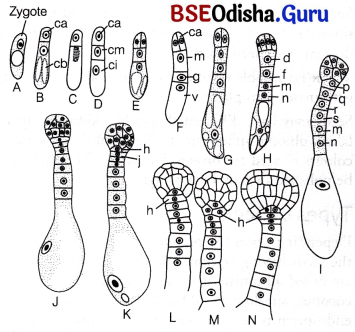
Successive stages of the development of proembryo in Capsella bursa-pastons
Question 31.
(i) Describe the endosperm development in coconut.
(ii) Why is tender coconut considered a healthy source of nutrition?
Answer:
(i) In coconut, endosperm formation is nuclear type.
The primary endosperm nucleus undergoes nuclear division without cell wall formation.
(ii) Soft coconut is an endosperm. It is rich in nutrients like fats, proteins, carbohydrates, minerals, vitamins, etc. Hence, it is considered as a healthy source of nutrition.
Question 32.
Double fertilisation is reported in plants of both, castor and groundnut. However, the. mature seeds of groundnut are non-albuminous and castor are albuminous. Explain the post-fertilisation events that are responsible for it.
Answer:
Double fertilisation is reported in both castor and groundnut but their mature seeds are different in terms of endosperm. The primary endosperm nucleus formed after fertilisation divides mitotically without cytokinesis ‘ to initiate the formation of endosperm. At this stage, the endosperm is called free nuclear endosperm.
Then, cell wall formation occurs and the endosperm becomes cellular type. The number of free nuclei formed before cellularisation varies gready. Endosperm ‘ may be completely utilised by the developing embryo before the maturation of seeds as in groundnut. Such seeds are called non-albuminous or non-endospermic seeds. When a portion of endosperm remains in seeds and is used up during seed germination, such seeds are called albuminous or endospermic seeds, e.g. castor.
![]()
Question 33.
Write short note on parthenocarpy.
Answer:
Parthenocarpy
The formation of fruits without fertilisation is termed as parthcnocarpy. The term parthenocarpy was coined by Noll (1902). The parthenocarpic development of fruit may require the pollination stimulus (stimulative parthenocarpy) or it may occur in unpollinated flowers (vegetative parthenocarpy).
Seedless fruits should not be considered synonymous to parthenocarpic fruits because in a seedless fruit the ovules may have been fertilised and later aborted, e.g. Vizir vinifrra.
There may be parthenocarpic fruits with seeds in them. Auxin treatments arc known o produce seeded parthenocarpic fruits in Citrus, grapes, etc.
Question 34.
What is apomixis? Comment on its significance. How can it be commercially used?
Or Write short note on apomixis.
Answer:
Apomixis is a type of asexual reproduction that mimics sexual reproduction, i.e. in which seeds are produced without fertilisation. Here, the embryos can develop directly from the nucellus, integuments, synergid or egg of a diploid embryo sac. The plants produced by apomixis are genetically similar to the parent plant. They maintain and exhibit all the good characteristics of the parent plant without any risk of segregation of hybrid characters as in case of sexually reproducing plants. The information gained from genetics of apomixis can be commercially used in transfer of apomictic genes into hybrid varieties. The production of hybrid seeds by sexual reproduction every year, is too expensive for farmers.
Long Answer Type Questions
Question 1.
Give an account of the development of male gametophyte in angiosperms.
Answer:
Development of a Male Gametophyte
Microspore is the first cell of male gametophyte. It involves formation of microsporangium and development of male gametophyte at pre-pollination and post-pollination events. The structures are stages which lead to development of male gametophyte are as follows
Stamen:
It is the male reproductive unit of angiosperm.
It consists of two parts
(i) The long and slender stalk called the filament.
(ii) The terminal generally bilobed structure called the anther.
The anther and filament are connected by a connective.
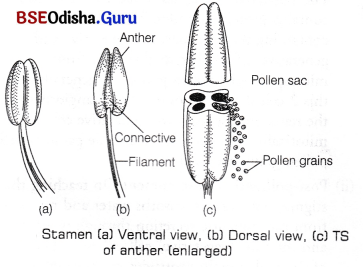
Stamen (a) Ventral view, (b) Dorsal view, (c) TS of anther (enlarged)
Structure of an Anther:
A typical angiosperm anther is bilobed structure with each lobe having two theca (dithecous) and separated by a longitudinal groove running lengthwise.
In a cross-section, the anther is a four-sided (tetragonal) structure consisting of four microsporangia located at the corners, two in each lobe. Later, the microsporangia develop and become pollen sacs, which are packed with the pollen grains.
Formation of Microsporangium (Pollen Sacs):
A typical microsporangium is surrounded by four wall layers, i.e. the epidermis, endothecium, middle layer and the tapetum. The outer three wall layers are protective in function and help in dehiscence of anther to release pollen grains. Tapetum (innermost layer) nourishes the developing microspores or pollen grains and the cells of tapetum possess dense cytoplasm and generally have more than one nucleus. When the anther is young, a group of compactly arranged homogenous cells called the sporogenous tissue occupies the centre of each microsporangium.
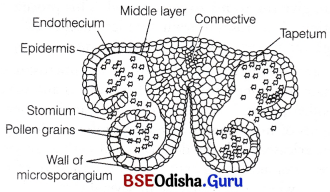
Transverse section of a mature anther
A young anther possesses a homogenous mass of hypodermal cells bounded by epidermis. After some time, this homogenous mass appears like a tetra-angular mass. Inner to this epidermis, some cells at each angle contain a prominent nucleus and abundant protoplasm, they are . called archesporial cells.
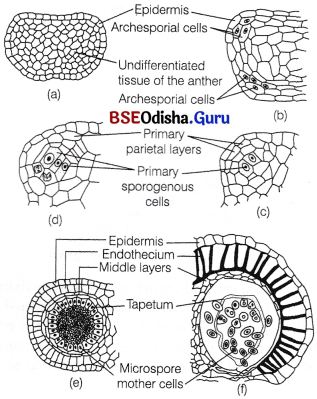
Development of microsporangium (a-e) successive stages of the development of microsporangium, (f) A mature pollen sac in a
These cells undergo periclinal division (parallel to the outerwall of the epidermal cells) to form outer parietal cells and inner sporogenous cells. The parietal cells divide by anticlinal and periclinal divisions to form 2-5 layered microsporangial wall. The sporogenous cells either directly function as microspore mother cells or go through some mitotic divisions and then junction as Microspore Mother Cells (MMCs).
Microsporogenesis:
Each cell of the sporogenous tissue is a potential Pollen Mother Cell (PMC) or microspore mother cell and can give rise to microspore tetrad. This process of formation of microspore from a pollen mother cell through the process of meiosis is called microsporogenesis.
As the anthers mature and dehydrate, the microspores dissociate from one another and form tetrad and develop into pollen grains. Inside each microsporangium, several thousands of microspores or pollen grains are formed that are released with the dehiscence of anther. In general, dehiscence of anther occurs through the rupture of anther lobe walls which causes release of several thousands of pollen grains at a time.
The Microspore or Pollen Grain:
It is a haploid, uninucleate and minute spore produced in large numbers by meiosis in the microspore mother cell. They vary in their size, shape, colour, design, etc., from species to species.
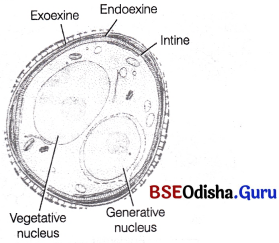
Structure of pollen grain
Pollen grains are generally spherical measuring about 25-50 micrometer in diameter. It has a two layered wall (also called sporoderm), outer hard layer exine is made up of sporopollenin. It is the most resistant organic material as it can withstand high temperature and strong acids and alkali.
No known enzyme can degrade it. Thus, pollens are well preserved as fossils. Pollen grains have prominent distal aperture for germination called germ pore, where sporopollenin is absent. The inner intine layer is thin and chiefly composed of cellulose and pectin.
In insect pollinated pollen grains, the exine is covered by a yellowish viscous and sticky substance called pollenkitt which emits smell. The definite function of pollenkitt is not known but it is believed that it helps in attracting insects and protects the pollen from ultraviolet radiation.
Study of pollen grains is known as palynology. The pollen grain on further development forms a male gametophyte.
Formation of Male Gametophyte:
(i) Pre-pollination development Development of male gametophyte starts in pollen grains while still present in the microsporangium or pollen sact The nucleus of pollen grain grows in size, moves to one side near the wall and divides mitotically to form a vegetative cell and a generative-cell. A layer of callose develops around the generative cell. Later on, the callose dissolves and the naked generative cell comes to lie freely in the cytoplasm of the tube cell. The cytoplasm of generative cell does not ‘ contain much of stored food. The shape of generative cell is elongated which helps in its passage through pollen tube.
The vegetative cell contains stored food and also contains protein granules. The microspore containing the two cells, i.e. vegetative and generative cell, is shed at this stage from microsporangia. Pollen grains are generally shed at this 2-celled stage in over 60% of angiosperms. In the remaining species, the generative cell divides mitotically and gives rise to 2 male gametes before pollen grains are shed.
(ii) Post-pollination development On reaching the stigma, pollen grain absorbs water and nutrients from the stigmatic secretion through its germ pores and the tube (vegetative) cell enlarges. The intine of the pollen grain protrudes out through one of the germ pores and a pollen tube is formed. The pollen tube pierces the stigmatic surface and moves down through the style of the pistil.
Now in the generative cell, the nucleus divides mitotically to form two male nuclei which become surrounded by a thin cytoplasmic sheath and appear as distinct non-motile male gametes. The nucleus of the generative cell, migrates to pollen tube. As the pollen tube elongates, the distal part becomes highly vacuolated and becomes separated from the anterior part containing the three nuclei, by formation of callose plug.
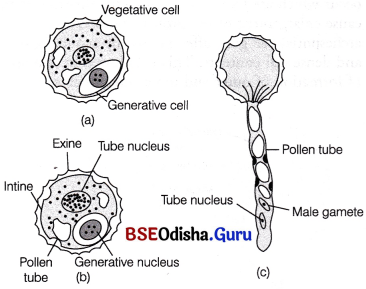
(a-b) Mature pollen grain, (c) Pollen germination
![]()
Question 2.
Gives the structure of a typical pollen grain and its pre and post-pollination changes.
Answer:
Formation of Male Gametophyte:
(i) Pre-pollination development Development of male gametophyte starts in pollen grains while still present in the microsporangium or pollen sact The nucleus of pollen grain grows in size, moves to one side near the wall and divides mitotically to form a vegetative cell and a generative-cell. A layer of callose develops around the generative cell. Later on, the callose dissolves and the naked generative cell comes to lie freely in the cytoplasm of the tube cell. The cytoplasm of generative cell does not ‘ contain much of stored food. The shape of generative cell is elongated which helps in its passage through pollen tube.
The vegetative cell contains stored food and also contains protein granules. The microspore containing the two cells, i.e. vegetative and generative cell, is shed at this stage from microsporangia. Pollen grains are generally shed at this 2-celled stage in over 60% of angiosperms. In the remaining species, the generative cell divides mitotically and gives rise to 2 male gametes before pollen grains are shed.
(ii) Post-pollination development On reaching the stigma, pollen grain absorbs water and nutrients from the stigmatic secretion through its germ pores and the tube (vegetative) cell enlarges. The intine of the pollen grain protrudes out through one of the germ pores and a pollen tube is formed. The pollen tube pierces the stigmatic surface and moves down through the style of the pistil.
Now in the generative cell, the nucleus divides mitotically to form two male nuclei which become surrounded by a thin cytoplasmic sheath and appear as distinct non-motile male gametes. The nucleus of the generative cell, migrates to pollen tube. As the pollen tube elongates, the distal part becomes highly vacuolated and becomes separated from the anterior part containing the three nuclei, by formation of callose plug.

(a-b) Mature pollen grain, (c) Pollen germination
Question 3.
Give an account of the development of female gametophyte in angiosperms.
Answer:
Female Gametophyte (Embryo Sac)
In general, the development of embryo sac is monosporic, e.g. in Polygonum. In this type of development, only one megaspore situated towards chalazal end remains functional, while the remaining three megaspores gradually degenerate and finally disappear. Following are the different stages in development of female gametophyte
1. The functional haploid megaspore is the first cell of female gametophyte of angiosperm.
2. It enlarges in size to form the female gametophyte, also called embryo sac.
3. Its nucleus undergoes mitotic division to form 2-nuclei that move to opposite poles forming 2-nucIeate embryo sac.
4. The 2-nucleate embryo sac undergoes two more sequential mitotic divisions giving rise to the 4-nucleate stage and later 8-nucleate stage of embryo sac. This stage comprises of a micropylar end and a chalazal end with four nuclei at each end.
5. Six of the eight nuclei are surrounded by cell walls and get organised into cells. Three cells present towards the micropylar end grouped together, constitute the egg apparatus, i.e. two synergids and one egg cell.
6. Three cells of the chalazal end are called the antipodals. The large central cell is formed by the fusion of 2-polar nuclei. Thus, a typical angiospermic embryo sac or female gametophyte at maturity consists of 8-nuclei and 7-cells.
The egg cell combines with a male gamete to form zygote which becomes the embryo. The pollen tube makes its way through the synergids releasing the male gametes.
One male gamete fuses with female gamete(egg) called syngamy. The two polar nuclei which have fused to form secondary nucleus combine with second male gamete and form primary endosperm cell. This primary endosperm cell develops into endosperm which provides nutrition to the developing embryo. The antipodal cells degenerate.
